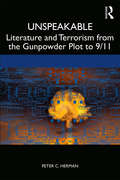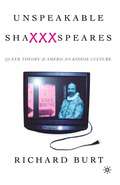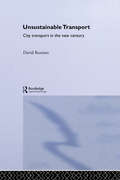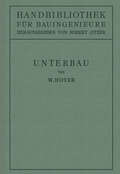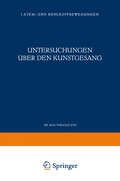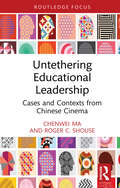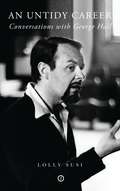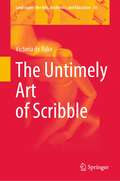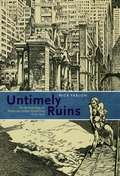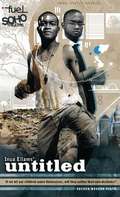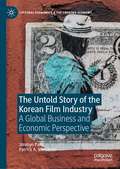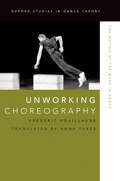- Table View
- List View
Unspeakable: Literature and Terrorism from the Gunpowder Plot to 9/11
by Peter C. HermanUnspeakable: Literature and Terrorism from the Gunpowder Plot to 9/11 explores the representation of terrorism in plays, novels, and films across the centuries. Time and time again, writers and filmmakers including William Shakespeare, Joseph Conrad, Henry James, Gillo Pontecorvo, Don DeLillo, John Updike, and Steven Spielberg refer to terrorist acts as beyond comprehension, “a deed without a name,” but they do not stop there. Instead of creating works that respond to terrorism by providing comforting narratives reassuring audiences and readers of their moral superiority and the perfidy of the terrorists, these writers and filmmakers confront the unspeakable by attempting to see the world from the terrorist’s perspective and by examining the roots of terrorist violence.
Unspeakable ShaXXXspeares, Revised Edition: Queer Theory and American Kiddie Culture
by NA NAUnspeakable ShaXXXspeares is a savvy look at the wide range of adaptations, spin-offs, and citations of Shakespeare's plays in 1990s popular culture. What does it say about our culture when Shakespearean references turn up in television episodes of The Brady Bunch and Gilligan's Island, films such as In and Out and My Own Private Idaho, and hardcore porn adaptations of Hamlet and Romeo and Juliet? Burt reads the reception of these often quite bad replays in relation to contemporary youth culture and the "queering" of Shakespeare.
Unstable Aesthetics: Game Engines and the Strangeness of Modding
by Eddie LohmeyerThroughout the 1990s, artists experimented with game engine technologies to disrupt our habitual relationships to video games. They hacked, glitched, and dismantled popular first-person shooters such as Doom (1993) and Quake (1996) to engage players in new kinds of embodied activity. In Unstable Aesthetics: Game Engines and the Strangeness of Art Modding, Eddie Lohmeyer investigates historical episodes of art modding practices-the alteration of a game system's existing code or hardware to generate abstract spaces-situated around a recent archaeology of the game engine: software for rendering two and three-dimensional gameworlds. The contemporary artists highlighted throughout this book-Cory Arcangel, JODI, Julian Oliver, Krista Hoefle, and Brent Watanabe, among others –- were attracted to the architectures of engines because they allowed them to explore vital relationships among abstraction, technology, and the body. Artists employed a range of modding techniques-hacking the ROM chips on Nintendo cartridges to produce experimental video, deconstructing source code to generate psychedelic glitch patterns, and collaging together surreal gameworlds-to intentionally dissect the engine's operations and unveil illusions of movement within algorithmic spaces. Through key moments in game engine history, Lohmeyer formulates a rich phenomenology of video games by focusing on the liminal spaces of interaction among system and body, or rather the strangeness of art modding.
Unstable Aesthetics: Game Engines and the Strangeness of Modding
by Eddie LohmeyerThroughout the 1990s, artists experimented with game engine technologies to disrupt our habitual relationships to video games. They hacked, glitched, and dismantled popular first-person shooters such as Doom (1993) and Quake (1996) to engage players in new kinds of embodied activity. In Unstable Aesthetics: Game Engines and the Strangeness of Art Modding, Eddie Lohmeyer investigates historical episodes of art modding practices-the alteration of a game system's existing code or hardware to generate abstract spaces-situated around a recent archaeology of the game engine: software for rendering two and three-dimensional gameworlds. The contemporary artists highlighted throughout this book-Cory Arcangel, JODI, Julian Oliver, Krista Hoefle, and Brent Watanabe, among others –- were attracted to the architectures of engines because they allowed them to explore vital relationships among abstraction, technology, and the body. Artists employed a range of modding techniques-hacking the ROM chips on Nintendo cartridges to produce experimental video, deconstructing source code to generate psychedelic glitch patterns, and collaging together surreal gameworlds-to intentionally dissect the engine's operations and unveil illusions of movement within algorithmic spaces. Through key moments in game engine history, Lohmeyer formulates a rich phenomenology of video games by focusing on the liminal spaces of interaction among system and body, or rather the strangeness of art modding.
Unsupervised Learning in Space and Time: A Modern Approach for Computer Vision using Graph-based Techniques and Deep Neural Networks (Advances in Computer Vision and Pattern Recognition)
by Marius LeordeanuThis book addresses one of the most important unsolved problems in artificial intelligence: the task of learning, in an unsupervised manner, from massive quantities of spatiotemporal visual data that are available at low cost. The book covers important scientific discoveries and findings, with a focus on the latest advances in the field. Presenting a coherent structure, the book logically connects novel mathematical formulations and efficient computational solutions for a range of unsupervised learning tasks, including visual feature matching, learning and classification, object discovery, and semantic segmentation in video. The final part of the book proposes a general strategy for visual learning over several generations of student-teacher neural networks, along with a unique view on the future of unsupervised learning in real-world contexts. Offering a fresh approach to this difficult problem, several efficient, state-of-the-art unsupervised learning algorithms are reviewed in detail, complete with an analysis of their performance on various tasks, datasets, and experimental setups. By highlighting the interconnections between these methods, many seemingly diverse problems are elegantly brought together in a unified way. Serving as an invaluable guide to the computational tools and algorithms required to tackle the exciting challenges in the field, this book is a must-read for graduate students seeking a greater understanding of unsupervised learning, as well as researchers in computer vision, machine learning, robotics, and related disciplines.
Unsustainable Transport: City Transport in the New Century (Transport, Development and Sustainability Series)
by David BanisterThis book addresses the links between transport and sustainable urban development, from an analysis of the global picture to issues in transport and energy intensity, public policy and the institutional and organisational constraints on change. The central part of the book explores these links in more detail at city level, covering land use and development, economic measures, and the role that technology can play. The final part looks for inspiration from events in developing countries and the means by which we can move from the unsustainable present to a more sustainable future.
Unsustainable Transport: City Transport in the New Century (Transport, Development and Sustainability Series)
by David BanisterThis book addresses the links between transport and sustainable urban development, from an analysis of the global picture to issues in transport and energy intensity, public policy and the institutional and organisational constraints on change. The central part of the book explores these links in more detail at city level, covering land use and development, economic measures, and the role that technology can play. The final part looks for inspiration from events in developing countries and the means by which we can move from the unsustainable present to a more sustainable future.
Unterbau: II. Teil Eisenbahnwesen und Städtebau. (Handbibliothek für Bauingenieure)
by W. HoyerDieser Buchtitel ist Teil des Digitalisierungsprojekts Springer Book Archives mit Publikationen, die seit den Anfängen des Verlags von 1842 erschienen sind. Der Verlag stellt mit diesem Archiv Quellen für die historische wie auch die disziplingeschichtliche Forschung zur Verfügung, die jeweils im historischen Kontext betrachtet werden müssen. Dieser Titel erschien in der Zeit vor 1945 und wird daher in seiner zeittypischen politisch-ideologischen Ausrichtung vom Verlag nicht beworben.
Unterrichtsentwicklung macht Schule: Forschung und Innovation im Fachunterricht
by Angelika Bikner‐Ahsbahs Maria PetersDieser Sammelband stellt die Ergebnisse aus dem Forschungsverbund der Creative Unit FaBiT (Universität Bremen) vor. Zunächst werden Innovation und Wandel im Fachunterricht aus philosophischer, kritisch-pädagogischer und institutioneller Sicht betrachtet. Dann wird illustriert, wie fachbezogene Designprojekte zu einem forschungsorientierten Entwicklungsmotor für Schule werden können. Die Vielfalt kreativer Lösungen und die Systematik der Forschung werden an der Entwicklung von Designprinzipien in fünf beteiligten Doktorarbeiten eindrucksvoll illustriert. Im letzten Teil wird Forschung für und mit Schulentwicklung als interdisziplinäre fachdidaktische Querschnittsforschung verstanden und deren Beitrag zur Unterrichtsentwicklung herausgearbeitet.
Untersuchungen über den Kunstgesang: I. Atem- und Kehlkopfbewegungen
by Max NadolecznyDieser Buchtitel ist Teil des Digitalisierungsprojekts Springer Book Archives mit Publikationen, die seit den Anfängen des Verlags von 1842 erschienen sind. Der Verlag stellt mit diesem Archiv Quellen für die historische wie auch die disziplingeschichtliche Forschung zur Verfügung, die jeweils im historischen Kontext betrachtet werden müssen. Dieser Titel erschien in der Zeit vor 1945 und wird daher in seiner zeittypischen politisch-ideologischen Ausrichtung vom Verlag nicht beworben.
Untersuchungen zur Resttragfähigkeit von gebrochenen Verglasungen: Investigation of the residual load-bearing behaviour of fractured glazing (Mechanik, Werkstoffe und Konstruktion im Bauwesen #45)
by Johannes FranzIm vorliegenden Band werden der Through-Cracked-Bending (TCB) Test und der Through-Cracked-Tensile (TCT) Test als zentrale Prüfmethoden zur Beurteilung des Resttragverhaltens von Verbundgläsern wie VSG und TVG beschrieben. Beide ermöglichen eine Klassifizierung der Zwischenschicht von VSG über den Vergleich mit der im Bauwesen üblicherweise verwendeten PVB-Folie und sind dem Haftzug- und Haftscherversuch sowie den derzeit genutzten Testverfahren, wie z. B. dem Pummeltest, überlegen. Für die Resttragfähigkeit kommt dem Delaminationsverhalten der Zwischenschicht im gebrochenen VSG, das als Ablösevorgang der Folie vom Glas zu interpretieren ist, eine besondere Bedeutung zu. Dieses wird anhand von PVB-Folien mit verschiedenen Haftgraden eingehend mit dem TCT Test bei unterschiedlichen Wegraten über die Bestimmung ihrer jeweiligen Energiefreisetzungsrate experimentell untersucht, wobei die Versuchsergebnisse mit Kohäsivzonenelementen der Methode der finiten Elemente abgebildet und beurteilt werden können.
Untethering Educational Leadership: Cases and Contexts from Chinese Cinema
by Chenwei Ma Roger C. ShouseLingdao, the Chinese word for leadership, is rarely used to denote acts of social persuasion that occur outside of contexts of formal rank or status. However, the ubiquity of informal leadership in China raises a number of practical and theoretical questions. Based on an analysis of selected Chinese cinematic works depicting settings of educational practice and policy, the book explores how "Western" understandings of leadership emerge from these texts to form discursive media for social change. It also offers a new understanding of lingdao and leadership; how they represent a natural human desire, regardless of formal rank or position, to mobilize collective will, change minds, and achieve social change. The book will be of interest to professional scholars and graduate students of Chinese culture, educational leadership, mass media, and popular culture.
Untethering Educational Leadership: Cases and Contexts from Chinese Cinema
by Chenwei Ma Roger C. ShouseLingdao, the Chinese word for leadership, is rarely used to denote acts of social persuasion that occur outside of contexts of formal rank or status. However, the ubiquity of informal leadership in China raises a number of practical and theoretical questions. Based on an analysis of selected Chinese cinematic works depicting settings of educational practice and policy, the book explores how "Western" understandings of leadership emerge from these texts to form discursive media for social change. It also offers a new understanding of lingdao and leadership; how they represent a natural human desire, regardless of formal rank or position, to mobilize collective will, change minds, and achieve social change. The book will be of interest to professional scholars and graduate students of Chinese culture, educational leadership, mass media, and popular culture.
An Untidy Career: Conversations with George Hall
by Lolly SusiLolly Susi's interviews with the actor and teacher George Hall are a unique insight into the mind of a great all-round theatre practitioner. It is a must read for actors,academics, students and theatre buffs. George Hall trained at Old Vic Theatre School and worked as an actor at the Old Vic, in regional theatre, on radio, television and film. He has worked in cabaret, as writer, composer, performer and director. He has composed scores for the Old Vic, Royal Shakespeare Company and for plays for film and television. George was director of the Acting Course at Central School of Speech and Drama for many years. He is currently on the staff of the Guildhall School of Music and Drama.
The Untimely Art of Scribble (Landscapes: the Arts, Aesthetics, and Education #34)
by Victoria de RijkeThis book offers new definitions, vocabularies and insights for “scribbling”, viewing it as a fascinating and revealing process shared by many different disciplines and practices. The book provides a fresh and timely perspective on the nature of mark making and the persistence of the gestural impulse from the earliest graphic marks to the most sophisticated artistic production. The typical treatment of scribbling in the literature of artistic development has cast the practice as a prelude to representation in drawing and writing, with only occasional acknowledgment of the continuing joy and experiment of making marks across many arts practices. The continuous line the author traces between the universal practice of scribbling in infancy and early childhood and the work of radical creativity for contemporary and historical artists is original and clarifying, expanding the range of drawing behaviors to that of avant-garde painters, performance and the digital.
Untimely Ruins: An Archaeology of American Urban Modernity, 1819-1919
by Nick YablonAmerican ruins have become increasingly prominent, whether in discussions of “urban blight” and home foreclosures, in commemorations of 9/11, or in postapocalyptic movies. In this highly original book, Nick Yablon argues that the association between American cities and ruins dates back to a much earlier period in the nation’s history. Recovering numerous scenes of urban desolation—from failed banks, abandoned towns, and dilapidated tenements to the crumbling skyscrapers and bridges envisioned in science fiction and cartoons—Untimely Ruins challenges the myth that ruins were absent or insignificant objects in nineteenth-century America. The first book to document an American cult of the ruin, Untimely Ruins traces its deviations as well as derivations from European conventions. Unlike classical and Gothic ruins, which decayed gracefully over centuries and inspired philosophical meditations about the fate of civilizations, America’s ruins were often “untimely,” appearing unpredictably and disappearing before they could accrue an aura of age. As modern ruins of steel and iron, they stimulated critical reflections about contemporary cities, and the unfamiliar kinds of experience they enabled. Unearthing evocative sources everywhere from the archives of amateur photographers to the contents of time-capsules, Untimely Ruins exposes crucial debates about the economic, technological, and cultural transformations known as urban modernity. The result is a fascinating cultural history that uncovers fresh perspectives on the American city.
Untimely Ruins: An Archaeology of American Urban Modernity, 1819-1919
by Nick YablonAmerican ruins have become increasingly prominent, whether in discussions of “urban blight” and home foreclosures, in commemorations of 9/11, or in postapocalyptic movies. In this highly original book, Nick Yablon argues that the association between American cities and ruins dates back to a much earlier period in the nation’s history. Recovering numerous scenes of urban desolation—from failed banks, abandoned towns, and dilapidated tenements to the crumbling skyscrapers and bridges envisioned in science fiction and cartoons—Untimely Ruins challenges the myth that ruins were absent or insignificant objects in nineteenth-century America. The first book to document an American cult of the ruin, Untimely Ruins traces its deviations as well as derivations from European conventions. Unlike classical and Gothic ruins, which decayed gracefully over centuries and inspired philosophical meditations about the fate of civilizations, America’s ruins were often “untimely,” appearing unpredictably and disappearing before they could accrue an aura of age. As modern ruins of steel and iron, they stimulated critical reflections about contemporary cities, and the unfamiliar kinds of experience they enabled. Unearthing evocative sources everywhere from the archives of amateur photographers to the contents of time-capsules, Untimely Ruins exposes crucial debates about the economic, technological, and cultural transformations known as urban modernity. The result is a fascinating cultural history that uncovers fresh perspectives on the American city.
Untimely Ruins: An Archaeology of American Urban Modernity, 1819-1919
by Nick YablonAmerican ruins have become increasingly prominent, whether in discussions of “urban blight” and home foreclosures, in commemorations of 9/11, or in postapocalyptic movies. In this highly original book, Nick Yablon argues that the association between American cities and ruins dates back to a much earlier period in the nation’s history. Recovering numerous scenes of urban desolation—from failed banks, abandoned towns, and dilapidated tenements to the crumbling skyscrapers and bridges envisioned in science fiction and cartoons—Untimely Ruins challenges the myth that ruins were absent or insignificant objects in nineteenth-century America. The first book to document an American cult of the ruin, Untimely Ruins traces its deviations as well as derivations from European conventions. Unlike classical and Gothic ruins, which decayed gracefully over centuries and inspired philosophical meditations about the fate of civilizations, America’s ruins were often “untimely,” appearing unpredictably and disappearing before they could accrue an aura of age. As modern ruins of steel and iron, they stimulated critical reflections about contemporary cities, and the unfamiliar kinds of experience they enabled. Unearthing evocative sources everywhere from the archives of amateur photographers to the contents of time-capsules, Untimely Ruins exposes crucial debates about the economic, technological, and cultural transformations known as urban modernity. The result is a fascinating cultural history that uncovers fresh perspectives on the American city.
Untitled (Oberon Modern Plays)
by Inua EllamsTo name something is to call it into life, to determine its future. If we let our children name themselves, will they author their own destinies? Will the nameless ones be free? Untitled is a magical realist story set in Nigeria and England, of identical twin boys separated at infancy. In the quarrel after the marred naming ceremony, the mother grabs the titled child and flees, leaving the unnamed brother to lead an impetuous, chaotic, blasphemous existence until the spirits of the land make their stand.
The Untold Story of the Korean Film Industry: A Global Business and Economic Perspective (Cultural Economics & the Creative Economy)
by Jimmyn Parc Patrick A. MesserlinThis book analyses the Korean film industry emergence and development in a global business and economic perspective. This is one of the first books to compare the film policies and industries of the world’s six largest film industries – featuring Korea as the central character – with the aim of defining the contours of what constitutes an effective film policy. It presents many cases showing that, contrary to what is often believed, an economically sound policy is a good instrument for achieving desired cultural goals. It uses a set of analytical tools – borrowed from the economic analysis of international trade policies – to provide a rich harvest of new, rigorous, and often unexpected results on the effectiveness of the existing film policies. The implications found in this book are relevant not only for Korea, but for all other countries that wish to foster or enhance the competitiveness of their film industries. This book will be of interest to a wide spectrum of scholars interested in cultural studies – media and cultural specialists, political scientists, sociologists, historians – in addition to business analysts and economists specialized in cultural economics. As this book focuses on film policies and how to improve them, it will also appeal to policymakers, business figures, public relations officials, and staff from international organizations working on the film industry.
Unveiling Fashion: Business, Culture, and Identity in the Most Glamorous Industry (INSEAD Business Press)
by F. GodartProposing a comprehensive account of the global fashion industry this book aims to present fashion as a social and cultural fact. Drawing on six principles from the industry, Godart guides the reader through the economic, social and political arena of the world's most glamorous industry.
Unworking Choreography: The Notion of the Work in Dance (Oxford Studies in Dance Theory)
by Frédéric PouillaudeThere is no archive or museum of human movement, no place where choreographies can be collected and conserved in pristine form. The central consequence of this is the incapacity of philosophy and aesthetics to think of dance as a positive and empirical art. In the eyes of philosophers, dance refers to a space other than art, considered both more frivolous and more fundamental than the artwork without ever quite attaining the status of a work. Unworking Choreography develops this idea and postulates an unworking as evidenced by a conspicuous absence of references to actual choreographic works within philosophical accounts of dance; the late development and partial dominance of the notion of the work in dance in contrast to other art forms such as painting, music, and theatre; the difficulties in identifying dance works given a lack of scores and an apparent resistance within the art form to the possibility of notation; and the questioning of ends of dance in contemporary practice and the relativisation of the very idea that dance artistic or choreographic processes aim at work production.
UNWORKING CHOREOGRAPHY OSDT C: The Notion of the Work in Dance (Oxford Studies in Dance Theory)
by Frédéric PouillaudeThere is no archive or museum of human movement, no place where choreographies can be collected and conserved in pristine form. The central consequence of this is the incapacity of philosophy and aesthetics to think of dance as a positive and empirical art. In the eyes of philosophers, dance refers to a space other than art, considered both more frivolous and more fundamental than the artwork without ever quite attaining the status of a work. Unworking Choreography develops this idea and postulates an unworking as evidenced by a conspicuous absence of references to actual choreographic works within philosophical accounts of dance; the late development and partial dominance of the notion of the work in dance in contrast to other art forms such as painting, music, and theatre; the difficulties in identifying dance works given a lack of scores and an apparent resistance within the art form to the possibility of notation; and the questioning of ends of dance in contemporary practice and the relativisation of the very idea that dance artistic or choreographic processes aim at work production.
Unwrapping Ancient Egypt
by Christina RiggsFirst runner-up for the British-Kuwait Friendship Society Book Prize in Middle Eastern Studies 2015. In ancient Egypt, wrapping sacred objects, including mummified bodies, in layers of cloth was a ritual that lay at the core of Egyptian society. Yet in the modern world, attention has focused instead on unwrapping all the careful arrangements of linen textiles the Egyptians had put in place.This book breaks new ground by looking at the significance of textile wrappings in ancient Egypt, and at how their unwrapping has shaped the way we think about the Egyptian past. Wrapping mummified bodies and divine statues in linen reflected the cultural values attached to this textile, with implications for understanding gender, materiality and hierarchy in Egyptian society. Unwrapping mummies and statues similarly reflects the values attached to Egyptian antiquities in the West, where the colonial legacies of archaeology, Egyptology and racial science still influence how Egypt appears in museums and the press.From the tomb of Tutankhamun to the Arab Spring, Unwrapping Ancient Egypt raises critical questions about the deep-seated fascination with this culture – and what that fascination says about our own.
Unwrapping Ancient Egypt
by Christina RiggsFirst runner-up for the British-Kuwait Friendship Society Book Prize in Middle Eastern Studies 2015. In ancient Egypt, wrapping sacred objects, including mummified bodies, in layers of cloth was a ritual that lay at the core of Egyptian society. Yet in the modern world, attention has focused instead on unwrapping all the careful arrangements of linen textiles the Egyptians had put in place.This book breaks new ground by looking at the significance of textile wrappings in ancient Egypt, and at how their unwrapping has shaped the way we think about the Egyptian past. Wrapping mummified bodies and divine statues in linen reflected the cultural values attached to this textile, with implications for understanding gender, materiality and hierarchy in Egyptian society. Unwrapping mummies and statues similarly reflects the values attached to Egyptian antiquities in the West, where the colonial legacies of archaeology, Egyptology and racial science still influence how Egypt appears in museums and the press.From the tomb of Tutankhamun to the Arab Spring, Unwrapping Ancient Egypt raises critical questions about the deep-seated fascination with this culture – and what that fascination says about our own.
